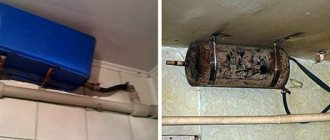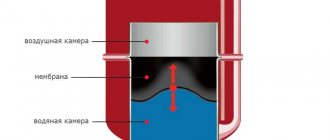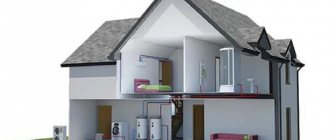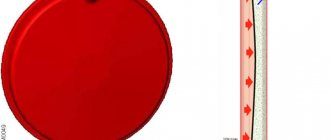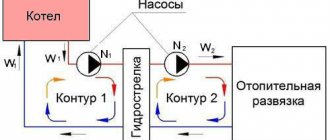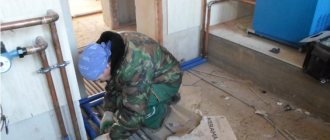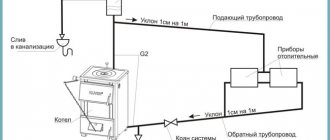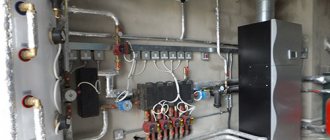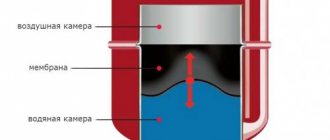Calculation of an expansion tank for a closed type of heating
Special containers are used to compensate for the increase in coolant as the temperature rises. A membrane tank is installed in a closed heating system.
Diaphragm tank for closed system
Below are the features of a typical design with the assignment of typical functional components:
- a flexible sealed partition divides the working volume into two parts;
- one is connected through a pipe to the heat supply main;
- air is pumped into the other under the required pressure;
- Corrosion-resistant materials are used to create the body;
- Fixing large models in a horizontal position is ensured by a stand.
The membrane expansion tank is installed in any place convenient for users. Easy access for maintenance should be ensured. Using a built-in fitting with a valve, air is added (bleeded) to create the required pressure.
Calculation of an expansion tank for a closed heating system begins with determining the amount of liquid in the system. The most accurate data can be obtained at the filling stage. Sequential addition of containers for pipelines, radiators, and other components is also used.
To quickly calculate the total volume of coolant, specialized specialists often use approximate proportions.
Below are the values (in liters) per 1 kW of boiler power when connecting different types of equipment:
- steel convectors (6-8);
- aluminum, cast iron radiators (10-11);
- warm floor (16-18).
If a combination of different heating devices is used to heat a private house, take 15 l/1 kW. With a gas boiler power of 7.5 kW, the following calculation result will be obtained: 7.5 * 15 = 112.5 liters.
The appropriate dimensions of the expansion tank for closed-type heating depend on several parameters:
- total volume of water supply and connected devices;
- coolant type;
- maximum pressure;
- temperature conditions.
When filling the heating system with water, the volume increases by 4% as the temperature rises from 0 C to +95 C. To prevent freezing in winter, the coolant is supplemented with ethyl glycol.
This mixture expands 10% more compared to the example discussed above (4.4%). Similar amendments are made when installing refrigeration systems.
The summary table shows the expansion coefficients of water (mixture).
This data will help you make an accurate choice of expansion tank:
| Ethylene glycol concentration in % | Coolant temperature, °C | ||||
| 20 | 60 | 80 | 100 | ||
| 0,00013 | 0,00177 | 0,0171 | 0,0290 | 0,0434 | |
| 20 | 0,0064 | 0,008 | 0,0232 | 0,0349 | 0,0491 |
| 40 | 0,0128 | 0,0144 | 0,0294 | 0,0407 | 0,0543 |
The calculation of the expansion tank for heating (O) is carried out using the formula O = (Oc x Kr) / E, where:
- Os – total volume of functional components;
- Kr – correction factor (from the table for a certain coolant composition);
- E – tank efficiency.
The last position is calculated as follows: E = (Ds-Db)/ (Ds+1), where D is the pressure:
- Ds - maximum in the hot water supply system (standard for private houses 2-3 atm);
- Db is compensating, which is taken equal to static (0.1 atm for each meter of building height).
Methods for calculating an expansion tank for heating
Expansion tanks for heating systems
How to calculate the volume of an expansion tank? There is a general selection method - the volume of the membrane vessel is selected at the rate of 10% of the total internal volume of the entire heating complex.
More often, exact calculations using formulas are used. Anyone can do it using a calculator. The volume of the expansion tank for heating is calculated by the formula:
A = VxC/K, where B is the volume of coolant; C – indicator of thermal expansion of the coolant; K is an indicator of the efficiency of the membrane tank.
The coolant volume is calculated using three methods:
- Geometric - based on the internal volume of heating devices, boilers and pipelines;
- When filling the system - using a meter or by adding when filling manually;
- Generalized method - for 1 kW of boiler thermal power, 15 liters of system volume are taken.
The generalized method has a refined modification depending on the type of heating appliances. When using radiators, the amount of water in them is on average 11 liters, in convectors - 7 liters, in a heated floor circuit - up to 18 liters. The volume of the heat exchanger is indicated in the equipment passport; the amount of water in the pipelines can be determined by calculating their length and internal volume. These indicators are summed up (boiler, pipes, appliances) - the result is the total volume of the heating complex.
After calculating the volume of the system, it is done using the following formula:
K = (DM – DB)/(DM+1), where DB is the maximum coolant pressure, usually taken equal to the response pressure of the safety valve in the safety group (3 atm.); DB – set air pressure in the air chamber of the expansion tank.
The thermal expansion rate of water is 4% when heated to 95 degrees Celsius. If the coolant contains non-freezing fractions, the indicator increases depending on the percentage of additives. At 10% of the additive in the total volume, the water indicator of 4% is multiplied by a correction factor of 1.1, at 30% - by 1.3, and so on.
Connection to the heating system
We connect the prepared circuit directly to the heating system. From a safety point of view, it must be remembered that a solid fuel boiler can produce an excessively high temperature at certain moments. The storage barrel can contain water at a temperature of 90-100 degrees. This is too much for standard home heating radiators. You can get seriously burned if accidentally touched. For this reason, it is necessary to add another mixing valve to the circuit. He will mix cooled water into the circuit.
If the house has heated floors, it is possible to connect them to the radiator circuit for return flow. Another pump will need to be installed. The connection will go to the mixing unit. Due to the high temperature, water is not drawn directly from the heated heat exchanger, but through a safety mixing valve. This part is installed so that when working with the system and checking it, you do not get scalded by hot steam.
At the next stage, we connect the coolant recirculation line in the system through a special pump. We arrange check valves in the circuit in accordance with the diagram. With this complete set of functional elements, let's move on to the fittings.
Another filter needs to be installed in front of the boilers. Then we install additional automatic air vents at the highest points of the system. Next, we ensure that the system is drained and filled. To do this, we arrange the ball valves so that in the future we can carry out technical inspection and repair of equipment without draining the coolant from the circuit. Cranes are needed for:
- expansion tank;
- boilers;
- pump
In cases where boilers do not have standard thermometers, they are installed additionally. You will also need two control thermometers located on the buffer tank. They will make it easier to monitor the operation of the system and set it up.
Additional devices in the heating system
Heating system circulation pump
Additional accessories include, for example, a pump. In a heating system located on an area of less than 100 m2, circulation will occur naturally, but for a larger area a pump is required. If the boiler is imported and automatic, then the pump is already in the system, which means there is no need for an additional one.
You can easily find a domestic or imported pump on sale; all of them are suitable for systems with natural circulation. Pumps for heating systems cost from 1200 rubles. But a good one from 3500, it is less energy-consuming and silent, while being small in size. The pump is installed at the end of the natural circulation system with your own hands, specifically on the return line before entering the boiler. This way, its contact with hot water will be minimal, and it will last for a long time.
Another type of additional equipment includes the use of an expansion tank. The capacity of the expansion tank has a different volume of water and is selected precisely from these parameters. In automatic boilers, an expansion tank is already installed, but its volume of water is insufficient for a system with liquid circulation over an area of more than 100 m2. Why is it necessary to install an expansion tank in a heating system?
8th grade students understand that heated water expands. Inside the heating system, the temperature of the water changes all the time, drops in spring and autumn, rises in winter, which means its volume changes all the time. Excess water volume can be controlled using a special container, expansion tank or, as professionals say, an expansion tank. It must be installed with both automatic and natural circulation of water in the system.
- If the heating system has a closed circuit.
- The coolant has a certain level of capacity.
As volume increases, hydraulic pressure will build up in a closed pipe chain, which can damage it. Scientists have calculated that with an increase in temperature by 10 0 C, the volume of water increases by 0.3%. This is a small indicator for a small volume of water, but the system can contain up to 1 ton. Therefore, installing an expansion tank is necessary in any private home. You can install it yourself, and this design costs from 1200 rubles.
Having examined the main components of the heating system and the installation stages, it is clear that you can carry out the work yourself. And the low cost of components and correct calculations make a modern heating system economical and functional.
We are building or reconstructing a private house and are involved in the overhaul of an apartment. We will equip an office, a warm garage, a heated room for other purposes. We thought through the heating system, selected the main equipment: the boiler and its piping, the boiler, underfloor heating systems. Or, if this is an apartment, you decided to replace the existing heating device with a more aesthetic and efficient one, maybe add a few additional sections to the old battery. We will assume that we have already made a choice of the type of heating devices: stacked sectional cast iron, aluminum batteries, bimetallic devices or ready-made panel steel radiators. Let's not forget that the batteries must withstand the coolant pressure in the system, which in a multi-story building is an order of magnitude higher than in a cottage
To achieve thermal comfort, it is important for us to correctly calculate heating radiators
FAQ
http-equiv="Content-Type" content="text/html;″>class="reviewsblock">
How does the size of the house affect the amount of storage needed? The volume of the house does not affect in any way, the efficiency of the heating system and the power of the boiler do. After all, variables such as the required heat for heating per hour and the difference between supply and return are precisely indicators of the quality of your system.
The better the heat accumulator is insulated, the more efficiently it will work? According to installation requirements, such a container should only be located in a room with a positive temperature. In this case, standard insulation 10 cm thick will be sufficient. There are cases when such containers are buried in the ground to store more energy, but further maintenance of the system becomes very difficult.
Is this container only suitable for heating? It can be used in several ways. To provide a heating system or hot water. A solid fuel boiler or an electric boiler can be used as a source (an example operating at night with a two-zone meter installed and a preferential tariff). When using a solar collector, solar panels or a wind generator. View all construction myths
Expansion tank of an open heating system calculation and installation rules
Expansion tanks are used in all individual heating system designs. The main purpose of the expansion tank is to compensate for the volume of the heating system caused by the thermal expansion of the coolant.
Features of an open heating system tank
The fact is that the volume of coolant increases with increasing pressure, and if you do not provide additional capacity to accommodate the excess volume, then the pressure in the heating system can increase so much that a breakthrough occurs. To eliminate excess pressure in the system, an expansion tank is used.
In addition to all of the above, the expansion tank of an open heating system differs from tanks intended for closed systems. Closed systems use tanks that are not exposed to the atmosphere. In an open system, the use of such a tank is impossible, since excess pressure in the tank will create great resistance to the circulation of the coolant. Therefore, open tanks are used for open heating systems.
This is where the big disadvantage of open heating systems arises - the evaporation of the coolant from the tank. As a result, it is periodically necessary to monitor the coolant level in the tank and, if necessary, make up for losses.
In addition, for open heating systems it is important not only that the tank can communicate with the atmosphere, but also the correct calculation of the tank volume and proper installation and connection to the heating system
Calculation of the volume of an open expansion tank
Traditionally, the volume of the expansion tank is determined as 5% of the volume of the entire heating system. This is due to the fact that when the water temperature increases to 80 degrees, its volume increases by approximately 4%. By adding to this a small space so that water does not overflow over the edges of the tank another 1%, in total we obtain the volume of the expansion tank as a percentage of the volume of the entire heating system.
If a different coolant is used in an open system, then the volume of the tank should be adjusted based on the magnitude of the thermal expansion of the coolant used.
The most difficulties arise with calculating the volume of coolant in the heating system. To calculate the volume of the system, it is necessary to sum up the internal volume of all elements of the radiator, heating and boiler pipe system. Also, the volume of the system can be determined indirectly by the boiler power, based on the fact that 1 kW of boiler power is needed to heat 15 liters of coolant.
Installation and connection of an open expansion tank
Unlike a closed expansion tank, there are certain rules for an open one
The most important rule is that the tank must be located above the entire heating system. Otherwise, according to the principle of communicating vessels, water will flow out of it. This circumstance often leads to the refusal to install an open-type heating system, because
It is not always possible to conveniently install an expansion tank
This circumstance often leads to the refusal to install an open-type heating system, because It is not always possible to conveniently install an expansion tank.
The second important feature is that the tank must be connected to the return line. The fact is that on the return side the water temperature is lower, and, therefore, the water will evaporate more slowly. In addition, given the low return water temperature, you can connect the expansion tank to the system using a transparent hose, which will make it easier to control the amount of water in the system
In addition, given the low return water temperature, you can connect the expansion tank to the system using a transparent hose, which will make it easier to control the amount of water in the system.
Additionally, the expansion tank may have special pipes to prevent overflow and control the water level in the tank.
Calculator for calculating the volume of an expansion tank for a heating system
A closed heating system has many advantages. It is much more compact, since it does not require compliance with the rules for installing the expansion tank at the highest point, is easier to adjust, works more economically, and the coolant does not evaporate and does not come into contact with air, that is, it is not saturated with oxygen, which is very important for the durability of the metal elements of the boiler and radiators .
Calculator for calculating the volume of an expansion tank for a heating system
Compensation for the thermal expansion of water occurs through the installation of a membrane expansion tank, which can be mounted, for example, on the “return” in close proximity to the boiler. It is only necessary to correctly determine the parameters of this important element of the system. A calculator for calculating the volume of an expansion tank for a heating system will help us with this.
The necessary explanations for performing calculations are below the calculator itself.
Calculator for calculating the volume of an expansion tank for a heating system
Go to calculations
Explanations for calculating tank volume
It is clear that when installing a heating system, especially in conditions of limited space, you want to save as much free space as possible. However, the volume of the expansion tank cannot be less than the calculated value.
The calculation is based on the following formula:
Vb = Vt × Kt / F
Vb is the calculated volume of the expansion tank.
Vt is the volume of coolant in the system.
What to do with him?
- A practical way is to check the water meter during a test filling of the system.
- The most accurate way is to sum up the internal volumes of all elements of the system - boiler, pipes, radiators, etc.
- The simplest “theoretical” method - without fear of making a serious mistake, you can accept the ratio of 15 liters of coolant for every kilowatt of heating boiler power. It is this dependence that is included in the calculation calculator.
Kt is a coefficient that takes into account the thermal expansion of the applicable coolant. This indicator depends on the content of antifreeze additives in the coolant, and changes both with the percentage of these additives and with increasing temperature, and nonlinearly. There are special tables, but in our case, these data are already entered into the calculator - based on the average heating of the coolant to +70÷80 ºС (this is the most optimal operating mode of the autonomous heating system).
If the system uses water, this must be noted in the appropriate field of the calculator.
Prices for expansion tanks for heating systems
expansion tank for heating system
What can be used as a coolant?
For private houses, which can be left by the owners for a long time in winter with the heating turned off, it is more advisable to use non-freezing liquids - antifreeze. About the variety of coolants for heating systems , about their properties, advantages and disadvantages - in a special publication on our portal.
F is the so-called efficiency coefficient of the membrane expansion tank. It is expressed by the following dependence:
F = (Pmax – Pb) / (Pmax + 1)
F is the calculated tank efficiency coefficient.
Pmax is the maximum pressure in the system, which corresponds to the response threshold of the emergency valve in the “safety group”. This parameter must be indicated in the passport data of the boiler equipment.
Pb is the pumping pressure of the air chamber of the expansion tank. The product may arrive pre-inflated - then this parameter will be indicated in the passport. However, this value can also be changed - the air chamber is pumped up, for example, by a car pump, or, conversely, excess air is released from it - for this there is a special nipple on the tank. As a rule, in autonomous heating systems it is recommended to pump the air chamber to a level of one to one and a half atmospheres.
What other elements are required in a closed heating system?
In order to properly plan and install heating in a house or apartment, you need to know its structure and the relationship of all the main devices and elements. A special publication on our portal tells in detail about a closed-type heating system
How to correctly calculate the required volume of the expansion tank
In order to carry out a correct and error-free calculation of the expansion tank for heating, you should calculate the total volume of the heating network. To do this, you need to add up the volume of the heating boiler, the total volume of all pipes connected to the heating system, as well as the volume of additional heating devices, if present. The formula for calculating the volume of the expansion tank is K = (KE x Z) / N, in which:
- KE is the total volume of the entire heating system;
Z is the constant expansion value of the coolant fluid;
N is the efficiency value of the membrane tank.
It is almost impossible to make a perfectly accurate calculation of the volume of the expansion tank for heating and the entire heating system. Well, approximately it is calculated based on the value that 1 kW of heating equipment power is equal to 15 liters of coolant volume. In general, it turns out that the average power for an ordinary home is 44 kW. Based on this, the formula turns out to be KE = 15x44 = 660 l. The expansion constant of the liquid is about 4%, for systems that use ordinary water with a maximum heating temperature of 95 degrees Celsius. Often, it is not water that is pumped into systems, but ethylene glycol in different percentages. In this case, the expansion coefficient is calculated using the formula:
10% - 4% x 1.1 = 4.4% 20% - 4% x 1.2 = 4.8%
Often, the performance of a membrane tank is indicated by the manufacturer, but it is not difficult to calculate it yourself:
N= (DV-DS) / (DV+1)
where: DV is the highest permissible pressure value in the system, as a rule, it is equal to the permissible pressure of the safety valve and for ordinary household heating systems rarely exceeds 2.5 - 3 bar. DS is the initial charging pressure of the membrane tank based on a constant value in half the atmosphere for 5 meters of the heating system.
As a result, it turns out that if the total area of the room in which the heating system is installed is 400 square meters. m., the maximum upper point of the system is 5 m, and the design power of the equipment is 44 kW, then the required volume of the tank with these values will be:
KE 44x15=660l.DV 2.5 bar; DS =0.5 barN (2.5 - 0.5) / (2.5+1) = 0.57K 660×0.04 / 0.57 = 46.2
Based on the data obtained, it is necessary to select an expansion tank for heating with a volume of 50 liters, with an initial pressure of 0.5 bar. For example, a Reflex NG 50 membrane tank. There are also standard approximate values for standard heating system elements:
- Radiators about 10.5 l.
Warm floors and other heating surfaces 17.0 l.
Convectors 7.0 l.
The coefficient of increase-expansion of the volume of water and water-glycol mixture depending on temperature indicators:
| °C | Glycol content, % | |||||||
| 10 | 20 | 30 | 40 | 50 | 70 | 90 | ||
| 0,00013 | 0,0032 | 0,0064 | 0,0096 | 0,0128 | 0,0160 | 0,0224 | 0,0288 | |
| 10 | 0,00027 | 0,0034 | 0,0066 | 0,0098 | 0,0130 | 0,0162 | 0,0226 | 0,0290 |
| 20 | 0,00177 | 0,0048 | 0,0080 | 0,0112 | 0,0144 | 0,0176 | 0,0240 | 0,0304 |
| 30 | 0,00435 | 0,0074 | 0,0106 | 0,0138 | 0,0170 | 0,0202 | 0,0266 | 0,0330 |
| 40 | 0,0078 | 0,0109 | 0,0141 | 0,0173 | 0,0205 | 0,0237 | 0,0301 | 0,0365 |
| 50 | 0,0121 | 0,0151 | 0,0183 | 0,0215 | 0,0247 | 0,0279 | 0,0343 | 0,0407 |
| 60 | 0,0171 | 0,0201 | 0,0232 | 0,0263 | 0,0294 | 0,0325 | 0,0387 | 0,0449 |
| 70 | 0,0227 | 0,0258 | 0,0288 | 0,0318 | 0,0348 | 0,0378 | 0,0438 | 0,0498 |
| 80 | 0,0290 | 0,0320 | 0,0349 | 0,0378 | 0,0407 | 0,0436 | 0,0494 | 0,0552 |
| 90 | 0,0359 | 0,0389 | 0,0417 | 0,0445 | 0,0473 | 0,0501 | 0,0557 | 0,0613 |
| 100 | 0,0434 | 0,0465 | 0,0491 | 0,0517 | 0,0543 | 0,0569 | 0,0621 | 0,0729 |
Formula for calculating the expansion of a liquid when temperature changes:
V = A x VT / (1– Pmin / Pmax.) / K.
Where:
VT is the total volume of coolant in the system
A – coefficient of expansion of the coolant at the maximum possible temperature
Pmin (atm.) – initial pressure in the expansion tank
Pmax (atm.) – maximum permissible pressure value
K is the filling coefficient of the expansion tank, which determines the maximum volume of liquid (as a percentage of the total volume of the membrane tank) that the expansion tank can accommodate. According to the table:
| Pmax-maximum pressure, atm. | Pmin—initial pressure, atm. | ||||||||
| 0,5 | 1,0 | 1,5 | 2,0 | 2,5 | 3,0 | 3,5 | 4,0 | 5,0 | |
| 1,0 | 0,25 | ||||||||
| 1,5 | 0,40 | 0,20 | |||||||
| 2,0 | 0,50 | 0,33 | 0,16 | ||||||
| 2,5 | 0,58 | 0,42 | 0,28 | 0,14 | |||||
| 3,0 | 0,62 | 0,50 | 0,37 | 0,25 | 0,12 | ||||
| 3,5 | 0,67 | 0,55 | 0,44 | 0,33 | 0,22 | ||||
| 4,0 | 0,70 | 0,60 | 0,50 | 0,40 | 0,30 | 0,20 | |||
| 4,5 | 0,63 | 0,54 | 0,45 | 0,36 | 0,27 | 0,18 | |||
| 5,0 | 0,58 | 0,50 | 0,41 | 0,33 | 0,25 | 0,16 | |||
| 5,5 | 0,62 | 0,54 | 0,47 | 0,38 | 0,30 | 0,23 | |||
| 6,0 | 0,57 | 0,50 | 0,42 | 0,35 | 0,28 | ||||
| 6,5 | 0,60 | 0,53 | 0,46 | 0,40 | 0,35 | 0,20 | |||
| 7,0 | 0,56 | 0,50 | 0,44 | 0,38 | 0,25 | ||||
| 7,5 | 0,58 | 0,53 | 0,47 | 0,41 | 0,30 | ||||
| 8,0 | 0,56 | 0,50 | 0,45 | 0,33 | |||||
How to correctly calculate the volume of a tank for heating systems?
To correctly calculate the volume of the expansion tank, several factors are taken into account that influence this indicator:
- The capacity of the expansion machine directly depends on the amount of water in the heating system.
- The higher the permissible pressure in the system, the smaller the tank you will need.
- The higher the temperature to which the coolant is heated, the larger the volume of the device should be.
Reference. If you choose an expansion tank that is too large, it will not provide the required pressure in the system. A small tank will not be able to contain all the excess coolant.
Calculation formula
Vb=(Vс * Z)/N, in which:
Vc is the volume of water in the heating system. To calculate this indicator, multiply the boiler power by 15. For example, if the boiler unit power is 30 kW, then the amount of coolant will be 12*15 = 450 liters. For systems where heat accumulators are used, the capacity of each of them in liters must be added to the resulting figure.
Z is the coolant expansion index. This coefficient for water is 4%, so when calculating we take the number 0.04.
Attention! If another substance is used as a coolant, then the corresponding expansion coefficient is taken. For example, for 10% ethylene glycol it is 4.4%
N is an indicator of the efficiency of tank expansion. Since the walls of the device are made of metal, it can slightly increase or decrease in volume under pressure. To calculate N, you will need the following formula:
N= (Nmax—N)/(Nmax+1), where:
Nmax is the maximum pressure in the system. This number is from 2.5 to 3 atmospheres; to find out the exact figure, look at what threshold value the safety valve is set to in the safety group.
N is the initial pressure in the expansion tank. This value is 0.5 atm. for every 5 m height of the heating system.
Continuing the example with a 30 kW boiler, let’s assume that Nmax is 3 atm., the height of the system does not exceed 5 m. Then:
N=(3—0.5)/(3+1)=0.625;
Vb = (450*0.04)/0.625 = 28.8 l.
Important! The volumes of expansion tanks available on the market meet certain standards. Therefore, it is not always possible to buy a tank with a capacity that exactly matches the calculated value
In such a situation, purchase a device that is rounded up, since if the volume is slightly less than necessary, it may harm the system.
Calculation of the volume of the expansion tank for a system without automatic make-up:
Vrb. = Vtot. x βt x 1.1 x 1.2 x 1.5 , where
Vtot. - volume of the system, l βt - coefficient of thermal expansion of the liquid 1.1 - small margin (+10%) for calculation error 1.2 - additional volume of 20% for natural loss of water 1.5 - correction for the useful volume of the tank
For example, there are 200 liters of water in the system, then the volume of the expansion tank is Vrb. = 200 x 0.04 x 1.1 x 1.2 x 1.5 = 15.84 l
If the calculated volume (Vrb.) of the tank does not coincide with the volume from the model range, choose the next model closest in volume.
Heating system pressure
Network pressure arises as a result of several factors. It characterizes the effect of the coolant on the walls of the system elements. Before filling with water, the pressure in the pipes is 1 atm. However, as soon as the process of filling the coolant begins, this indicator changes. Even when the coolant is cold, there is pressure in the pipeline. The reason for this is the different arrangement of the system elements - with an increase in height by 1 m, 0.1 atm is added. This type of impact is called static, and this parameter is used when designing heating networks with natural circulation. In a closed heating system, the coolant expands during heating and excess pressure forms in the pipes. Depending on the design of the highway, it can change in different areas, and if stabilizing devices are not provided at the design stage, then there is a risk of system failure.
There are no pressure standards for autonomous heating systems. Its value is calculated depending on the parameters of the equipment, the characteristics of the pipes, and also takes into account the number of storeys of the house. In this case, you need to follow the rule that the pressure value in the network must correspond to its minimum value in the weakest link of the system. It is also necessary to remember about the mandatory difference of 0.3-0.5 atm. between the pressure in the forward and return pipes of the boiler, which is one of the mechanisms for maintaining normal coolant circulation. Taking all this into account, the pressure should be in the range from i.5 to 2.5 atm. To control pressure, pressure gauges are installed at various points in the network, which record low and excess values. In the event that the meter should not only serve for visual control, but also work in an automation system, electric contact or other types of sensors are used.
- The density of heated water is less than the density of cold water. The difference between these values leads to the creation of hydrostatic pressure, pushing hot water to the radiators
- For expansion tanks, the most informative are the maximum permissible values of temperature and pressure.
- According to manufacturers, in modern tanks the coolant temperature can reach 120 °C, and the operating pressure up to 4 atm. at peak values up to 10 bar
Method for calculating the volume of a membrane expansion tank for a heating system:
The calculation presented below is intended for individual heating systems and is significantly simplified. Its accuracy is 10%. We think this is quite enough
1. Let's determine what type of liquid you will use as a coolant. For an example of calculation, we will take water as a coolant. The coefficient of thermal expansion of water is assumed to be 0.034 (this corresponds to a temperature of 85oC)
2. Determine the volume of water in the system. It can be approximately calculated depending on the boiler power at the rate of 15 liters per kilowatt of power. For example, with a boiler power of 40 kW, the volume of water in the system will be equal to 600 liters
3. Determine the maximum permissible pressure in the heating system. It is set by the response threshold of the safety valve in the heating system
4. The calculations also use the value of the initial air pressure in the expansion tank Po. The Po pressure must not be less than the gyrostatic pressure of the heating system at the location of the expansion tank
5. The total expansion volume V can be calculated using the formula:
V = (ex C) / (1 - (Po/Pmax))
6. You need to select a tank by rounding the calculated volume up (a larger tank will not hurt)
7. Now let’s select a tank that provides compensation for this volume. Considering that the water filling coefficient of an expansion tank with a fixed, non-replaceable membrane under these conditions is 0.5 (table), then an 80-liter expansion tank is suitable for the system considered:
80 liters x 0.5 = 40 liters
Filling factor (useful volume) of the expansion membrane tank
Maximum pressure in the system Pmax, bar
| Initial pressure in the tank, Po bar | ||||||||
| 0,5 | 1,0 | 1,5 | 2,0 | 2,5 | 3,0 | 3,5 | 4,0 | |
| 1 | 0,25 | — | — | — | — | — | — | — |
| 1,5 | 0,40 | 0,20 | — | — | — | — | — | — |
| 2,0 | 0,50 | 0,33 | 0,16 | — | — | — | — | — |
| 2,5 | 0,58 | 0,42 | 0,28 | 0,14 | — | — | — | — |
| 3,0 | 0,62 | 0,50 | 0,37 | 0,25 | 0,12 | — | — | — |
| 3,5 | 0,67 | 0,55 | 0,44 | 0,33 | 0,22 | — | — | — |
| 4,0 | 0,70 | 0,60 | 0,50 | 0,40 | 0,30 | 0,20 | — | — |
| 4,5 | — | 0,63 | 0,54 | 0,45 | 0,36 | 0,27 | 0,18 | — |
| 5,0 | — | — | 0,58 | 0,50 | 0,41 | 0,33 | 0,25 | 0,16 |
| 5,5 | — | — | 0,62 | 0,54 | 0,47 | 0,38 | 0,30 | 0,23 |
| 6,0 | — | — | — | 0,57 | 0,50 | 0,42 | 0,35 | 0,28 |
Open type expansion tank for heating systems
Large heating structures use expensive closed tanks.
They are characterized by a sealed housing with an internal rubber partition (membrane), thanks to which the pressure is adjusted when the coolant expands.
For full operation of home systems, an open type expansion tank is a suitable alternative that does not require special knowledge or professional training for operation and further repair of equipment.
An open tank performs several functions for the smooth operation of the heating mechanism:
- “takes away” excess heated coolant and “returns” cooled liquid back to the system to regulate pressure;
- removes air, which, thanks to the inclination of the pipes by a couple of degrees, itself rises to the open expansion tank located at the top point of the heating system;
- The open design feature allows you to add the evaporated volume of liquid directly through the top cap of the tank.
Operating principle
The workflow is divided into four simple steps:
- the tank is two-thirds full in normal condition;
- an increase in the flow of liquid into the tank and an increase in the filling level when the coolant is heated;
- liquid leaving the tank when the temperature drops;
- stabilization of the coolant level in the tank to its original position.
Design
The shape of the expansion tank exists in three versions: cylindrical, round or rectangular. There is an inspection cover on the top of the housing.
Photo 1. Open type expansion tank design for heating systems. The components are indicated.
The case itself is made of sheet steel, but with a homemade version, other materials are also possible, for example, plastic or stainless steel.
Reference.
The tank is coated with an anti-corrosion layer to prevent premature destruction (primarily this applies to iron containers).
The open tank system includes several different pipes:
- to connect the expansion pipe through which water fills the tank;
- at the junction of the overflow, for pouring out excess;
- when connecting a circulation pipe through which the coolant enters the heating system;
- for connecting a control pipe designed to eliminate air and adjust the fullness of pipes;
- spare, necessary during repairs to discharge coolant (water).
Volume
The correctly calculated volume of the tank affects the duration of operation of the joint system and the uninterrupted functioning of individual elements.
A small tank will lead to breakdown of the safety valve due to frequent operation, and a tank that is too large will require additional finances when purchasing and heating an excess volume of water.
The availability of free space will also be an influential factor.
Appearance
An open tank is a metal tank, the upper part of which is simply closed with a lid, with an additional hole for adding water. The tank body can be round or rectangular. The latter option is more practical and reliable during installation and fastening, but the round one has the advantage of sealed seamless walls.
Important! A rectangular tank requires additional reinforcement of the walls with an impressive volume of water (homemade version). This makes the entire expansion mechanism heavier, which needs to be lifted to the highest point of the heating system, for example, to the attic.
Advantages:
- Standard form. In most cases, it is a rectangle that can be installed and connected to the general mechanism yourself.
- A simple design without an excessive number of control elements, which makes it easy to control the smooth operation of the tank.
- The minimum number of connecting elements, which gives the body strength and reliability during operation.
- Average market price, thanks to the above facts.
Flaws:
- Unattractive appearance, without the ability to hide thick-walled bulky pipes behind decorative panels.
- Low efficiency.
- Using water as a coolant. With other antifreezes, evaporation occurs faster.
- The reservoir is not sealed.
- The need to constantly add water (once a week or once a month) due to evaporation, which, in turn, affects airing and the normal functioning of the heating system.
- The presence of air bubbles leads to internal corrosion of system elements and a decrease in service life and heat transfer, and the appearance of noise.
How to calculate the volume of an expansion tank for closed heating
The heating system of a private home must be equipped with all the elements necessary for proper operation.
Attempts to do without some “unimportant” devices lead to emergency situations requiring serious repairs and restoration.
Moreover, even the complete presence of the necessary parts of the circuit will not ensure normal operation if they are selected incorrectly and do not match the characteristics.
All components must be carefully calculated and selected according to the data obtained.
The expansion tank is an element that protects the system from rupture if the permissible pressure is exceeded.
Being left without heating in the winter is a serious problem (read about repairs and diagnostics of plumbing problems in the bathroom here).
Therefore, reliable and correct operation of the expansion tank is a vitally important task.
How to calculate the volume of an expansion tank for an open heating system
In an open-type system, experts advise installing the tank at the highest point. This solution, together with expansion compensation, will ensure air removal without additional equipment. Of course, the room must be heated. If you decide to use the free space under the roof, you will need appropriate insulation.
In this case, an exact calculation of the expansion tank of the heating system is not required. To prevent emergency situations, a pipe built into the wall of the tank at a certain level is connected to the sewerage system.
Calculations
What you need to know when making calculations
When installing a heating system, it is not always possible to save useful space, which is so important in small rooms. But at the same time you can find out the exact volume of the required device
The following formula is used for calculations:
Vb (tank volume) = Vt (coolant fluid volume)*Kt (coefficient taking into account expansion under the influence of heat)/F (membrane tank performance coefficient)
To determine the volume of coolant, the following methods are used:
- The time of trial filling of the entire structure is recorded. This can be done using a water meter;
- all the volumes of the mechanisms present are added up - pipes, batteries and heat sources;
- a compliance of 15 liters of coolant fluid per kilowatt of equipment power is applied.
Calculation of volume using a separate example
The coefficient taking into account the thermal expansion of the coolant used depends on the presence of antifreeze additives. It varies depending on the percentage of these additives, and can also change under the influence of temperature. There are special tables where you can see data from the calculation of heating of the coolant. This information is entered into the calculator. If water is used, this is necessarily displayed in the program.
Non-freezing liquids as a coolant are especially relevant when it is necessary to turn off the heating during the cold season.
The efficiency coefficient of the membrane expansion tank must be taken into account. It can be determined by the following formula:
F= (Pm-Pb)/(P1+1)
In this case, Pm denotes the maximum pressure that can lead to emergency activation of a special safety valve. This value must be indicated in the product data sheet.
The diagram shows the device installation option
Pb is the pressure for pumping the air chamber of the device. If the structure has already been pumped up, then the parameter is indicated in the technical specifications. You can change this value yourself. For example, resupply with a car pump or remove excess air using a built-in nipple. For autonomous systems, the recommended value is 1-1.5 atmospheres.
Related article:
Save time: selected articles delivered to your inbox every week
How to use the calculation calculator
Still, volume is the basis of choice. The volumetric parameter of the device depends on some indicators that influence its changes. Namely:
- the larger the volume of coolant in a closed-type heating system, the larger the dimensions it is worth buying a tank;
- the higher the heating of the coolant, the greater the capacity of the device;
- The higher the pressure of the coolant (a possible coefficient is taken), the smaller the container can be purchased.
These are the main features. Now is the time to calculate the volume of the heating expansion tank. The most convenient way to do this is online using a calculator. All you have to do is fill out the form in the electronic calculator and click calculate.
How and where to install the expansion tank
So, we are going to design and assemble a heating system with our own hands. If it also starts working, our joy will know no bounds. Are there instructions for installing the expansion tank?
Open system
In this case, the answer will be prompted by simple common sense.
An open heating system is, in essence, one large vessel of complex shape with specific convection currents in it.
The installation of a boiler and heating devices in it, as well as the installation of pipelines, must ensure two things:
- Rapid rise of water heated by the boiler to the top point of the heating system and its drainage through the heating devices by gravity;
- Unhindered movement of air bubbles to where they will rush in any vessel with any liquid. Up.
- Installation of a heating expansion tank in an open system is always carried out at its highest point. Most often - at the top of the accelerating manifold of a single-pipe system. In the case of top-fill houses (although you hardly have to design them) - at the top filling point in the attic.
- The tank itself for an open system does not need shut-off valves, a rubber membrane, or even a lid (except to protect it from debris). This is a simple water tank open at the top, into which you can always add a bucket of water to replace the evaporated water. The price of such a product is equal to the cost of several welding electrodes and a square meter of steel sheet 3-4 millimeters thick.
This is what an expansion tank for an open heating system looks like. If desired, a water tap from the water supply can be brought into the hatch in it. But much more often, as the water evaporates, it is topped up with an ordinary bucket.
Expansion tank volume
The choice of expansion tank size depends on three main parameters:
- the volume of coolant in the system - the larger it is, the larger the dimensions of the tank should be;
- coolant temperature - the higher the heating, the greater the capacity of the expansion tank should be;
- pressure in the system - the higher its permissible value, the smaller the volume of the tank should be.
In other words, the volume of the expansion tank is directly dependent on the amount of coolant and its temperature, and inversely dependent on the pressure in the heating system.

